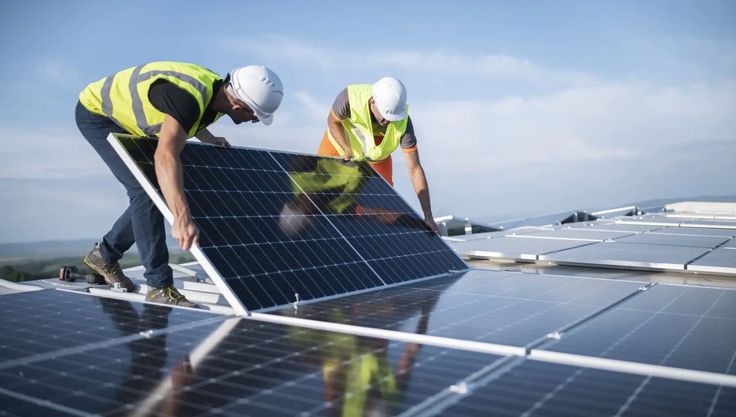
Comprehensive Solar Panel Maintenance Checklist
A solar panel maintenance checklist is essential to ensure optimal performance. Routine inspections should include checking for cracks, dirt, or shading issues. Follow the solar panel cleaning checklist to remove dirt and dust, maximizing energy absorption. Preventive solar panel maintenance involves inspecting electrical connections, ensuring secure connections, and checking for corrosion or loose cables.
A. How to Clean Your Solar Panels for Maximum Efficiency
Properly cleaning solar panels is crucial to maintain maximum sunlight absorption and ensure long-term efficiency. Start by following the solar panel cleaning checklist to prepare for the process. First, ensure safety by turning off the solar power system before cleaning. Use a non-abrasive sponge or soft cloth to remove dirt, dust, and bird droppings from the surface. Avoid using harsh chemicals, as they can damage the panel’s protective coating.
For optimal results, clean the panels in the morning or late afternoon to avoid the midday heat, which can cause water to evaporate quickly and leave streaks. Always use clean warm water mixed with mild soap if needed. Rinse thoroughly to prevent soap residue, which can reduce efficiency. For hard-to-reach areas, a long-handled soft brush or squeegee can help. Ensuring the panels are clean and free of debris allows them to absorb maximum sunlight, boosting energy production.
B. How to Inspect Connections and Cables
Inspecting connections and cables is vital for maintaining the efficiency and safety of your solar system. While the solar panel cleaning checklist often emphasizes surface cleaning, checking the connections between panels, mounting systems, and cables is equally important. Loose connections or corrosion can lead to energy loss and fire hazards.
Start by checking all cables to ensure they are securely connected. Look for common issues such as loose cables, which can cause poor electrical conductivity, or frayed cables, which increase the risk of short circuits. Watch for signs of wear on the mounting system, as structural damage can cause misalignment or additional stress on cables.
Cables should also be inspected for exposure to natural elements, as UV rays and moisture can degrade insulation over time. Tightening all connections, replacing damaged cables, and ensuring proper grounding are critical steps. A thorough inspection ensures your solar panels operate safely and efficiently.
C. How to Monitor Inverters and Charge Controllers
Monitoring inverters and charge controllers is essential for the overall performance of your solar power system. Following a solar inverter maintenance checklist ensures your system operates efficiently and helps prevent costly repairs. Start by checking the inverter display or monitoring system for error codes or unusual readings, such as a sudden drop in power output. This may indicate performance issues or potential malfunctions.
Inspect the physical condition of the inverter for signs of wear, including overheating, burnt components, or unusual noises, which may signal internal damage. Ensure all ventilation openings are free of dust and debris, as blocked airflow can cause the inverter to overheat. For charge controllers, check for corrosion around connections and ensure all cables are securely attached.
Common signs of malfunction in both devices include unstable power output, frequent disconnections, or excessive heat generation. Addressing these issues promptly and ensuring the system is properly grounded will optimize your solar power output and prevent equipment failure.
D. Solar Power System Maintenance Checklist
A comprehensive solar power system maintenance checklist goes beyond just cleaning panels. Routine inspections should include inverters, batteries, cables, and charge controllers. Following a solar inverter maintenance checklist is crucial, as the inverter converts solar energy into usable electricity. Check for error codes, overheating, and ensure adequate airflow to prevent malfunctions.
Batteries should be inspected for corrosion, proper charge levels, and signs of wear such as leaks or swelling. Ensuring tight battery connections and clean terminals will help extend battery life. Cable inspections are equally important—check for loose connections, torn cables, or exposure to elements that could affect efficiency or safety.
Preventive solar system maintenance checklists should also include inspecting the charge controller, which regulates energy flow to and from the battery. Look for signs of damage such as overheating or poor voltage regulation. Proper maintenance of all components ensures your system runs smoothly and efficiently, maximizing energy output and preventing costly repairs.
E. Preventive Maintenance: How to Ensure Longevity and Efficiency
Preventive maintenance is key to avoiding costly repairs and ensuring the longevity of your solar power system. By following a preventive solar panel maintenance checklist, you can identify minor issues before they become major problems. Routine inspections for cracks, dirt, and dust buildup help keep panels functioning optimally. A proper solar panel maintenance schedule should include regular cleaning to maximize sunlight absorption and electrical connection checks for signs of wear or corrosion.
Additionally, monitoring components such as inverters and charge controllers can prevent inefficiencies. Early detection of loose cables or damaged parts keeps the system running smoothly and avoids sudden breakdowns. Adhering to a consistent maintenance routine ensures the system operates at peak efficiency, extends its lifespan, and reduces long-term repair costs.
*Quoted from Various Sources



